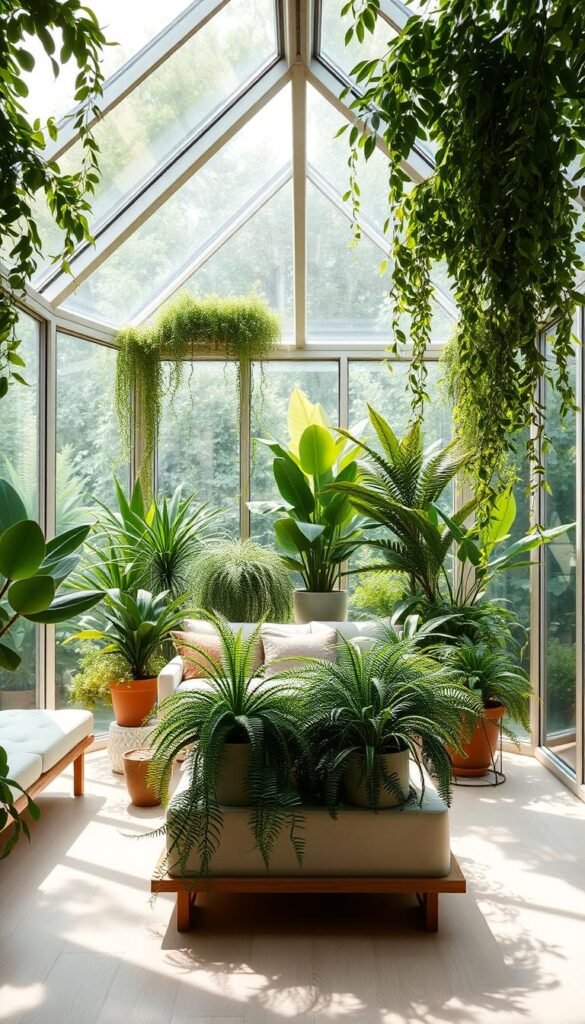Bringing nature into your living space doesn’t require a sprawling backyard. With the right approach, you can craft a serene oasis right inside your home. Indoor gardening lets you grow plants in controlled environments, adding life and tranquility to even the smallest corners. Whether you’re nurturing low-light ferns or arranging succulents in sleek pots, these living elements transform rooms into calming retreats.
Why does this matter? Studies show that spaces blending clean layouts with natural elements reduce stress and boost mood. By focusing on simplicity—like using neutral containers or grouping plants by height—you create visual harmony without clutter. For example, indoor garden designs for the modern often pair air-purifying species with materials like stone or wood for a balanced look.
You’ll learn how to select plants that thrive in your space’s light conditions while complementing your decor. Think sculptural snake plants in geometric planters or cascading pothos in hanging baskets. The goal? A setup that feels intentional, not overwhelming—perfect for busy lifestyles.
Ready to start? This guide walks through every step, from choosing the right greenery to arranging them for maximum impact. Let’s turn your home into a peaceful haven where nature and style coexist effortlessly.
Embracing Minimalist Aesthetics in Your Indoor Garden
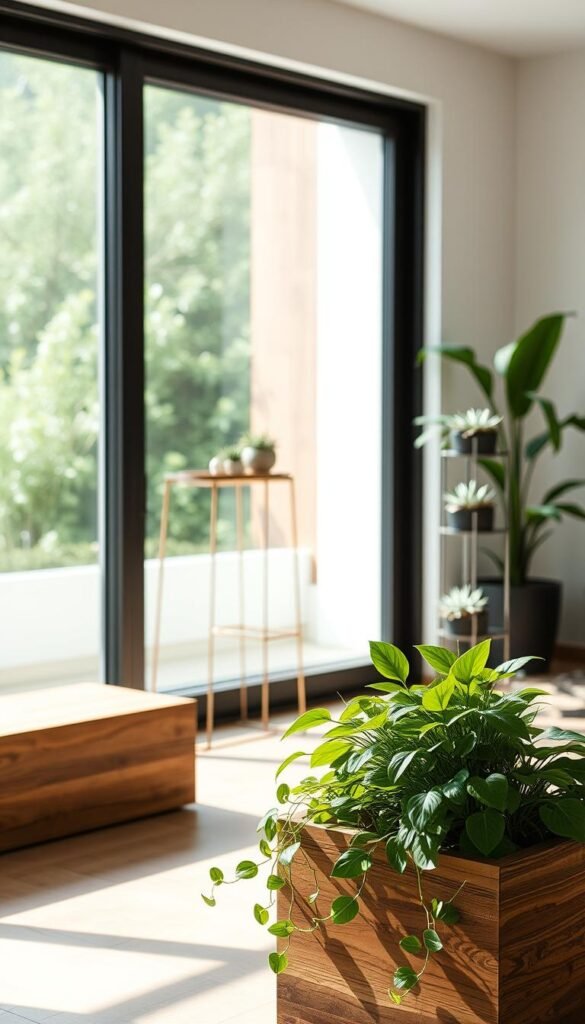
Creating a calming green retreat starts with intentional choices. Focus on simplicity through structured shapes and strategic lighting to let your plants shine without visual chaos.
Harnessing Clean Lines and Natural Light
Geometric planters create rhythm when aligned with furniture edges or architectural details. Position tall, slender plants near windows to cast artistic shadows during golden hour.
Maximize sunlight by placing mirrors opposite light sources. Frosted glass shelves or acrylic stands brighten darker corners while maintaining airy transparency. Light-colored walls act as natural reflectors, making your space feel larger.
Choosing Modern Materials and Finishes
Durable surfaces like polished concrete floors pair beautifully with organic textures. Consider these options:
| Material | Benefits | Plant Pairings |
|---|---|---|
| Brushed Steel | Reflects light, sleek look | Snake plants, ZZ plants |
| Natural Stone | Adds earthy contrast | Ferns, trailing ivy |
| Matte Ceramic | Softens harsh lines | Pothos, philodendrons |
Leave breathing room between decor items. A single striking specimen in a textured pot often makes stronger impact than crowded arrangements. Neutral tones in furnishings let vibrant greens take center stage.
Benefits of Bringing Greenery into Your Home
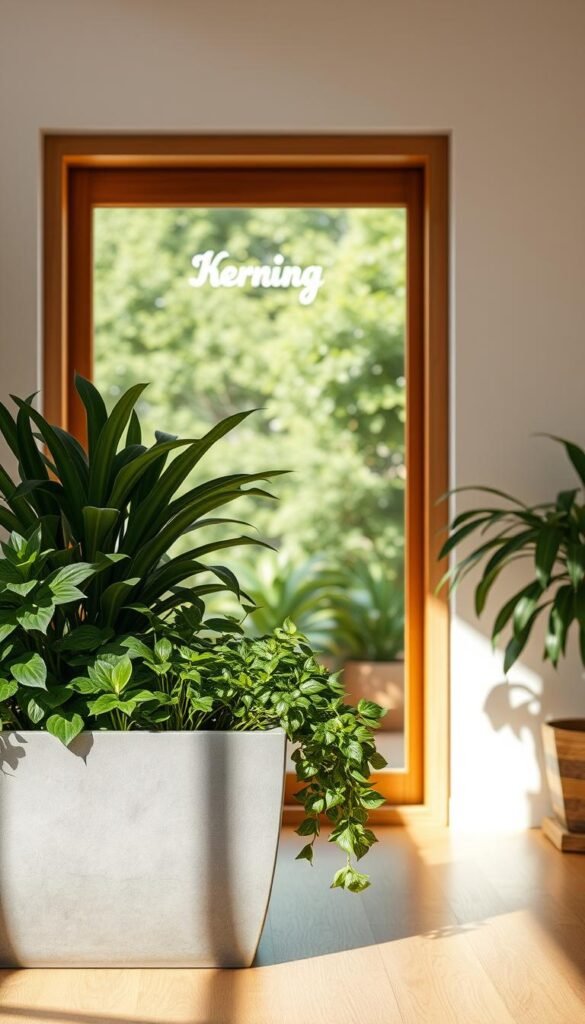
Surrounding yourself with plants offers more than just visual appeal—it transforms your living environment in surprising ways. Cleaner air tops the list of advantages. Species like peace lilies and snake plants act as natural filters, absorbing toxins such as formaldehyde from everyday items like furniture and cleaning products.
Feeling overwhelmed? Studies show spending time near greenery lowers cortisol levels by up to 30%. A 2022 NASA report confirms certain plant varieties remove 87% of airborne pollutants within 24 hours. This creates a calmer atmosphere where you can recharge after hectic days.
Your home becomes a productivity booster, too. Researchers at the University of Michigan found people working near foliage demonstrate 15% better focus. Try placing a pothos on your desk or a rubber tree in your living area. Their presence sparks creativity while softening harsh lines in urban spaces.
Sleep quality improves when you choose species like aloe vera or lavender for bedrooms. These releases oxygen at night, helping regulate humidity. Caring for your green companions also builds mindfulness—watering routines become moments of reflection rather than chores.
Whether you’re in a studio apartment or suburban house, nature bridges the gap between concrete jungles and outdoor serenity. Start small: a single spider plant on a windowsill proves even modest efforts yield measurable rewards for body and mind.
Designing a Modern Indoor Garden for Small Spaces
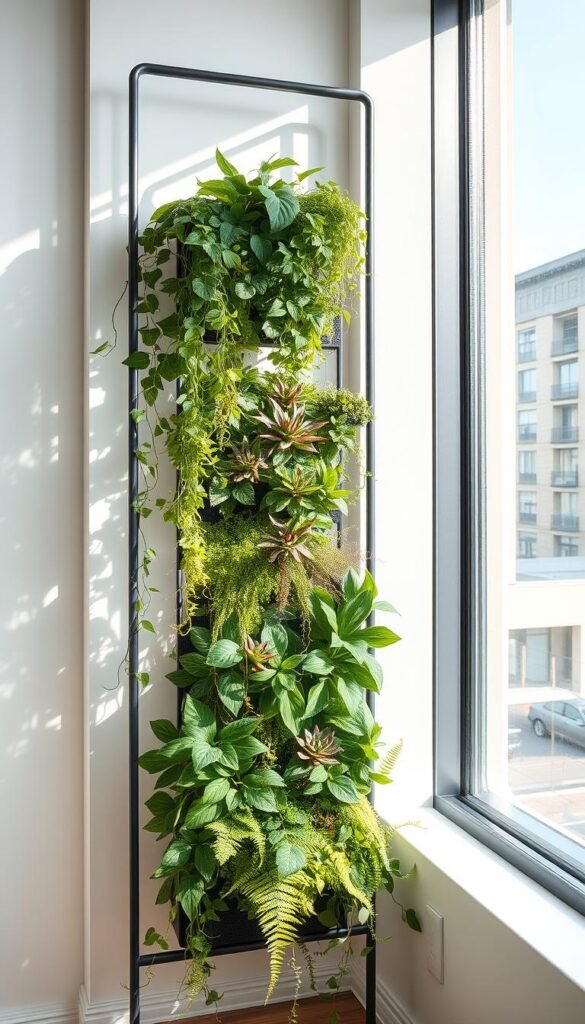
Limited square footage doesn’t mean sacrificing your green ambitions. Smart strategies let you grow thriving plants while keeping floors clear for daily activities. Focus on upward growth and dual-purpose items to merge beauty with functionality.
Reimagining Walls as Planting Zones
Turn blank walls into living art with these space-saving solutions:
| Vertical System | Best For | Plant Examples |
|---|---|---|
| Pocket Planters | Herbs & succulents | Basil, echeveria |
| Magnetic Pots | Air plants | Tillandsia |
| Ladder Shelves | Trailing varieties | String of pearls |
Install floating shelves near windows to display cascading pothos. Use adhesive hooks for lightweight hanging planters in corners that get indirect light. Rotate pots monthly for even growth.
Furniture That Works Double Duty
Choose pieces that hide clutter while showcasing plants. An ottoman with internal storage can hold gardening tools below and host a lush fern on top. Try these ideas:
- Bookshelves with integrated grow lights
- Side tables featuring built-in water reservoirs
- Room dividers containing propagation stations
Position mirrors behind plant clusters to amplify light and create depth. Pale-colored walls make rooms feel airier, while strategic spotlights highlight your green displays after dark.
Low-Maintenance Solutions for Your Indoor Garden

Busy schedules and lush greenery can coexist beautifully. The secret lies in choosing resilient species that adapt to your routine rather than demanding constant attention. Start with varieties that forgive missed waterings and thrive in diverse light conditions.
Selecting Plants That Thrive in Minimal Care
Top performers like ZZ plants and snake plants survive weeks without water while purifying air. Pothos vines trail elegantly from shelves, needing only monthly feeding. Consider these champions of easy care:
| Plant | Light Needs | Water Frequency | Special Features |
|---|---|---|---|
| Snake Plant | Low to bright | Every 3 weeks | Releases oxygen at night |
| ZZ Plant | Indirect light | Monthly | Purifies air |
| Spider Plant | Medium light | Biweekly | Non-toxic to pets |
Group moisture-loving peace lilies with pebble trays to simplify watering. “Plants should work for your lifestyle, not against it,” says urban gardener Lisa Chen. Use slow-release fertilizer sticks to nourish soil for months.
Self-watering pots with reservoirs support travel-heavy routines. Place light meters near windows to identify optimal spots without guesswork. With these strategies, your green oasis stays vibrant with just 10 minutes of weekly care.
Modern Indoor Garden Design: Minimalist Aesthetics and Greenery Combined
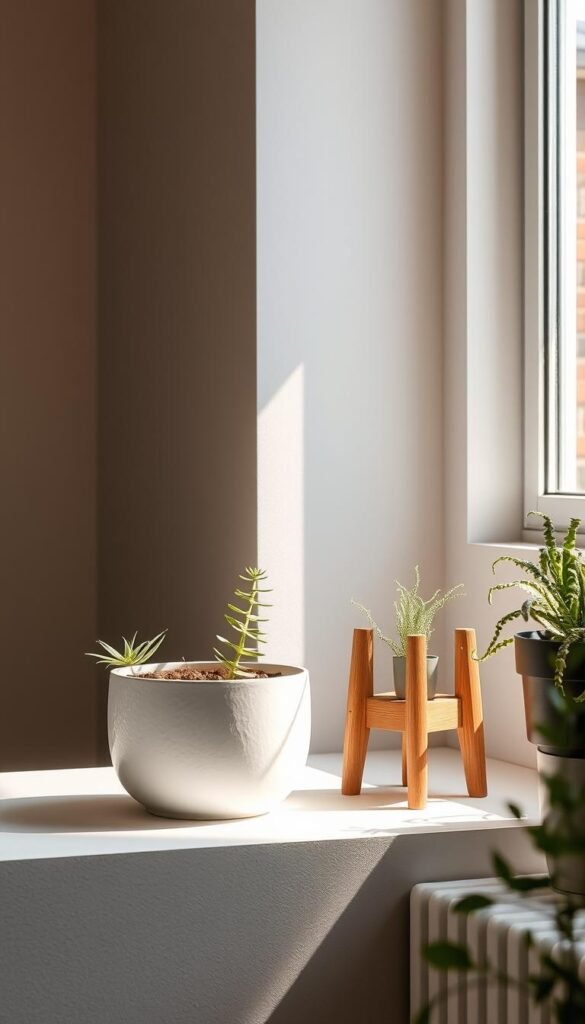
Transforming your living area into a peaceful retreat begins with purposeful simplicity. Focus on three key elements: intentional placement, curated selections, and strategic lighting. This approach lets each plant become a focal point rather than competing for attention.
Negative space acts like a frame for your greenery. Leave ample room between specimens to highlight their unique shapes. A single fiddle-leaf fig in a matte-black planter makes stronger impact than five crowded succulents.
Consider these essential components for balanced spaces:
| Design Element | Visual Impact | Plant Matches |
|---|---|---|
| Geometric planters | Create rhythm | Snake plants |
| Textured gravel beds | Add depth | Air plants |
| Adjustable track lights | Highlight features | ZZ plants |
Pair plants with complementary containers using companion plant pairings principles. A tall ceramic vase complements trailing ivy, while shallow stone bowls suit cacti clusters.
Light-colored walls amplify natural light, making rooms feel airier. Use sheer curtains to soften harsh sunlight. Rotate plants monthly to maintain symmetrical growth patterns.
This method reduces upkeep while elevating your space’s sophistication. You’ll spend less time rearranging and more time enjoying your personal oasis.
Incorporating Natural Materials and Stone Accents
Nature’s raw beauty becomes your design partner when you let materials speak for themselves. Stone pathways guide movement while adding earthy textures underfoot. Strategically placed bamboo clusters create rhythm without overwhelming your space.
Integrating Bamboo, Stone, and Japanese Maple Elements
Bamboo screens add vertical interest while softening harsh lines. Pair them with river rock borders for contrast. Japanese maples offer seasonal drama—their crimson leaves in fall become living art against gray stone walls.
Consider these pairings for balanced spaces:
| Material | Plant Partner | Maintenance Level |
|---|---|---|
| Slate tiles | Moss varieties | Low |
| Granite pebbles | Dwarf conifers | Moderate |
| Weathered brick | Climbing ivy | Minimal |
Textured walls develop character over time. A weathered brick backdrop lets trailing plants shine. “Materials should enhance, not compete,” notes landscape designer Mara Lin. Use bamboo poles as natural trellises for vining pothos.
Natural elements age beautifully. Patinas on stone surfaces add depth, while bamboo matures into richer hues. Keep arrangements simple—three materials per zone prevent visual clutter. Your space stays grounded yet refined.
Utilizing Smart Technologies for Effortless Gardening
Smart tools now let you cultivate thriving plants with minimal effort. These innovations handle routine tasks while optimizing growing conditions, perfect for busy plant lovers.
Automated Watering and Optimized Lighting Systems
Self-watering pots with moisture sensors eliminate overwatering risks. They release precise water amounts when soil dries out. Pair them with programmable LED grow lights that mimic natural daylight cycles.
| Technology Type | Key Features | Best For |
|---|---|---|
| Smart Pots | Wi-Fi alerts, reservoir base | Herbs, tropical plants |
| Full-Spectrum LEDs | Adjustable intensity, timers | Seedlings, flowering species |
| Climate Controllers | Humidity regulation, app integration | Orchids, ferns |
Grow lights let you create vibrant displays in windowless areas. Energy-efficient models use 40% less power than traditional bulbs. Combine them with container gardening ideas for urban balconies to maximize tight spaces.
Smartphone apps track plant health through connected sensors. Receive alerts when temperatures drop or nutrients deplete. One user reported, “My fiddle-leaf fig doubled in size after using light scheduling.”
These systems work together seamlessly. Set automated misters to activate when humidity dips below 50%. Watch your green oasis flourish while you focus on enjoying it.
Creative DIY Indoor Garden Ideas for Unique Spaces
Unleash your imagination with spaces that reflect your personality through living decor. Transform forgotten corners into vibrant displays using clever repurposing and thoughtful touches.
DIY Fairy Garden and Cactus Arrangements
Turn vintage teacups into magical landscapes with miniature ferns and sparkling gravel. Glass terrariums become self-contained worlds when layered with moss and tiny stone paths. For desert charm, mix spiky cacti in geometric planters using colored sand as bedding.
Personalizing Your Green Space with Artful Accessories
Add character with hand-painted pebbles or reclaimed wood signs. A miniature bench beside a tillandsia cluster creates whimsy, while polished stones guide the eye through your creation. These touches make each piece uniquely yours.

